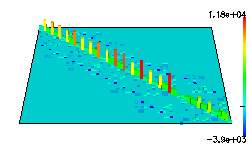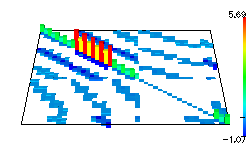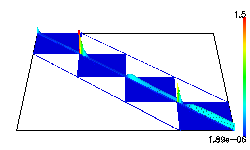
 bcsstk02 |
 dw2048 |
 fidapm05 |
 qc324 |
Cityplots provide a quick visual check on the sparsity pattern of the matrix, as well as on the relative magnitude of matrix entries.
For each matrix entry a 3-dimensional bar (a 'building' in the 'city') is drawn with it's height and color linearly scaled to the magnitude of the value. The first row in the matrix is at the top of the cityplot and the first column is to the left. The cityplot is drawn in perspective so the first row appears narrower than the last row. An outline of the matrix is drawn in the plane of an entry with zero value. For complex matrices the modulus (absolute value) of each element is displayed.
The color bar to the right is labeled with the minimum and maximum entry magnitudes. The tic mark indicates the zero value.
The detailed view of the cityplots has some additional labeling. The top of the cityplots are labeled with the collection/set/matrix name. At the bottom of the cityplot the number of rows, columns, and entries are indicated. If necessary, the number of nonzero entries and if the matrix is symmetric or complex is also shown. Symmetry is determined by the header line in the Matrix Market file for that matrix except if the matrix is purely diagonal.
The cityplot images are aliased. In other words, a stair step affect can be seen on the narrower bars. This artifact leads to other visual artifacts, particularly a "Moire pattern"-like affect for matrices with diagonals that have alternating large and small values.
When the order of the matrix is much larger than the number of pixels used to display it, the matrix can appear denser than it is. For example, the matrix psmigr_3 is a 3140x3140 matrix with only 5.5% of its entries nonzero. However, the nonzeros are distributed fairly uniformly, and hence when it is scaled down to be much smaller than 3140x3140 pixels it looks quite dense.
IBM Visualization Data Explorer was used to generate the cityplots with help from Holly Rushmeier at IBM.
We have also begun experimenting with the use of VRML to manipulate these 3D images. Several VRML demonstrations have been produced.
[ Home ] [ Search ] [ Browse ] [ Resources]
Last change in this page : 23 August 2012. [ ].